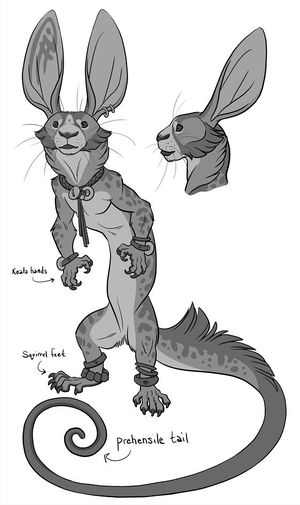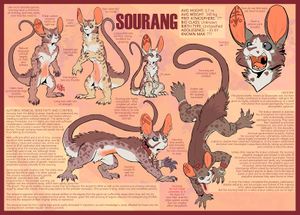Sourang: Difference between revisions
Added history section + a few cleanup edits. |
|||
| Line 18: | Line 18: | ||
Some sourang with a particular mastery of this skill have learned to edit and replace the DNA of other species with their own DNA, in order to alter their abilities. The method used in this process varies per sourang, but usually involves the injection of stem cells from a primed host into the bloodstream of a selected recipient. These stem cells collect to form a gland in the recipients body that then begins to release artificial and extremely aggressive viruses that destroy and replace the targeted DNA. typical genetic transfer is a long and very painful process that, depending on the modifications needed by the host, as well as the host species and many other factors, can take many months to complete. |
Some sourang with a particular mastery of this skill have learned to edit and replace the DNA of other species with their own DNA, in order to alter their abilities. The method used in this process varies per sourang, but usually involves the injection of stem cells from a primed host into the bloodstream of a selected recipient. These stem cells collect to form a gland in the recipients body that then begins to release artificial and extremely aggressive viruses that destroy and replace the targeted DNA. typical genetic transfer is a long and very painful process that, depending on the modifications needed by the host, as well as the host species and many other factors, can take many months to complete. |
||
==History== |
|||
History |
|||
The Sourang once lived on the planet that was eventually terraformed to become Krakuntec IV. Not much is known about the conditions of this planet before it was terraformed, primarily because most of its inhabitants were wiped out in the terraforming process. It is known however that the sourang were originally seen as an excellent slave race candidate due to their long lifespan and relative size/strength. |
|||
This plan however went badly wrong when as soon as they were sold, they would begin to escape, utilizing their biological skill to change their body composition to adapt to the environments they were enslaved in. There was a brief time where the Krakun experimented with re-education, brain washing, and even lobotomy, but these strategies only ended in either the sourang’s death or the loss of their usefulness in labor. Eventually the krakun empire reclassified them as pests, and made it illegal to own a sourang as a slave. |
|||
by then however, it was too late to stop the sourang invasion. They would make their way onto krakun ships throughout the empire, and spread across the planets, taking up residence in the walls and out of the way places in Krakun buildings. Soon, they were building communities inside these places, and according to a recent source, have in some places even established large trading networks between colonies throughout Krakun cities. |
|||
A few Sourang have even made it to the Lio empire. Mostly as stowaways aboard captured Krakun ships, they were sometimes brought back as sorts of trophies from great battles in which there are large amounts of captured Krakun ships. Most of the time, these sourang are considered refugees, and are granted citizenship to the Lio empire. There is a small sustained population living in the Lio empire, but the vast majority still live in Krakun territory. |
|||
==Music== |
==Music== |
||
While sourang do not have distinct melodic traditions, they are capable of recognizing pitches and learning to play pitched instruments with little biological interference. The majority of sourang musical tradition however is rooted in an extremely rich percussion heritage. Sourang have an unusually high sensitivity to differences between supposedly simultaneous strikes, being able to detect two distinct strikes that are as close to 20 milliseconds from each other. |
While sourang do not have distinct melodic traditions, they are capable of recognizing pitches and learning to play pitched instruments with little biological interference. The majority of sourang musical tradition however is rooted in an extremely rich percussion heritage carried with them all the way from their home planet. Sourang have an unusually high sensitivity to differences between supposedly simultaneous strikes, being able to detect two distinct strikes that are as close to 20 milliseconds from each other. |
||
This quirk of biology allows sourang percussion music to become extremely complex rhythmically, making extensive use of polyrhythms and very fast note runs. Due to the unique biology of their paws, they can grasp and create usable pivots with two drumsticks in each hand, allowing experienced percussionists to achieve a roll speed of up to 4000 strikes per minute. |
This quirk of their biology allows sourang percussion music to become extremely complex rhythmically, making extensive use of polyrhythms and very fast note runs. Due to the unique biology of their paws, they can grasp and create usable pivots with two drumsticks in each hand, allowing experienced percussionists to achieve a roll speed of up to 4000 strikes per minute. |
||
Revision as of 21:28, 3 August 2020


Overview
The Sourang are a large, quadrupedal, omnivorous species native to the terraformed planet now known as Krakuntec IV. Most of The population now exists either as stowaways aboard Krakun vessels, or as pests inside homes on various Krakun home worlds.
Culture
Sourang are typically highly xenophobic, believing themselves to be smarter than all other races, including the krakun. Their culture promotes trade, and supports the skeleton of a capitalist social structure.
Traditionally, sourang colonies do not have complex government or much leadership of any kind. Their society is maintained by the practice of promise making between individuals and groups. Sourang culture treats promise making in the same way that other races treat trade of goods. A promise to a sourang is the same as an object, a good that is exchanged with someone to obtain something else. To break a promise is the same as stealing another individual’s possession.
Appearance
Sourang are fairly large, measuring 2.5 to 3.5 meters in length, and weighing anywhere from 300 to 360 kilograms. They have relatively short fur all over their bodies, however the fur on their rump is longer. Their fur ranges in color from light brown, to reddish brown, to grey, and often has speckles of other colors mixed throughout their coats.
Biochemistry
Sourang have a natural Autobiochemical sense, which allows them sense, classify and control their bodily functions to a much greater degree than other races with no external study (without the need to research the bodies of the deceased). This sense is not always immediate, but it is extremely accurate with enough practice and self reflection. Sourang can use the knowledge gained from this to control much of their bodily functions including respiration, organ function, and nutrition needs.
Some sourang with a particular mastery of this skill have learned to edit and replace the DNA of other species with their own DNA, in order to alter their abilities. The method used in this process varies per sourang, but usually involves the injection of stem cells from a primed host into the bloodstream of a selected recipient. These stem cells collect to form a gland in the recipients body that then begins to release artificial and extremely aggressive viruses that destroy and replace the targeted DNA. typical genetic transfer is a long and very painful process that, depending on the modifications needed by the host, as well as the host species and many other factors, can take many months to complete.
History
History
The Sourang once lived on the planet that was eventually terraformed to become Krakuntec IV. Not much is known about the conditions of this planet before it was terraformed, primarily because most of its inhabitants were wiped out in the terraforming process. It is known however that the sourang were originally seen as an excellent slave race candidate due to their long lifespan and relative size/strength.
This plan however went badly wrong when as soon as they were sold, they would begin to escape, utilizing their biological skill to change their body composition to adapt to the environments they were enslaved in. There was a brief time where the Krakun experimented with re-education, brain washing, and even lobotomy, but these strategies only ended in either the sourang’s death or the loss of their usefulness in labor. Eventually the krakun empire reclassified them as pests, and made it illegal to own a sourang as a slave.
by then however, it was too late to stop the sourang invasion. They would make their way onto krakun ships throughout the empire, and spread across the planets, taking up residence in the walls and out of the way places in Krakun buildings. Soon, they were building communities inside these places, and according to a recent source, have in some places even established large trading networks between colonies throughout Krakun cities.
A few Sourang have even made it to the Lio empire. Mostly as stowaways aboard captured Krakun ships, they were sometimes brought back as sorts of trophies from great battles in which there are large amounts of captured Krakun ships. Most of the time, these sourang are considered refugees, and are granted citizenship to the Lio empire. There is a small sustained population living in the Lio empire, but the vast majority still live in Krakun territory.
Music
While sourang do not have distinct melodic traditions, they are capable of recognizing pitches and learning to play pitched instruments with little biological interference. The majority of sourang musical tradition however is rooted in an extremely rich percussion heritage carried with them all the way from their home planet. Sourang have an unusually high sensitivity to differences between supposedly simultaneous strikes, being able to detect two distinct strikes that are as close to 20 milliseconds from each other.
This quirk of their biology allows sourang percussion music to become extremely complex rhythmically, making extensive use of polyrhythms and very fast note runs. Due to the unique biology of their paws, they can grasp and create usable pivots with two drumsticks in each hand, allowing experienced percussionists to achieve a roll speed of up to 4000 strikes per minute.
